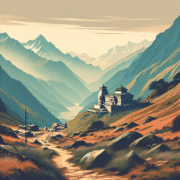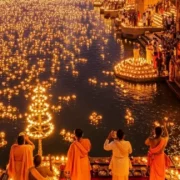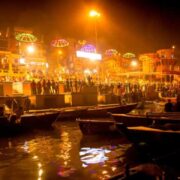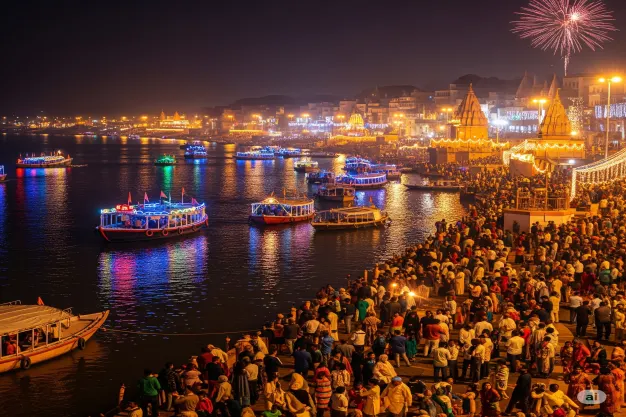
Varanasi Dev Deepawali: The Ultimate Travel Guide to the Festival of Lights on the Ganges
Varanasi, the world’s oldest living city, transforms into a heavenly abode during Dev Deepawali, the grand festival of lights celebrated on the ghats of the holy Ganges. While Diwali marks the triumph of good over evil, Dev Deepawali — observed fifteen days later on the full moon night of Kartik Purnima — is believed to be the day when gods descend to Earth to bathe in the sacred river.
Every corner of Varanasi gleams with millions of earthen lamps (diyas), enchanting chants, and mesmerizing rituals. For spiritual seekers, travelers, and photographers alike, Dev Deepawali offers an unforgettable experience — a blend of devotion, culture, and divine beauty.
The Spiritual Essence of Dev Deepawali
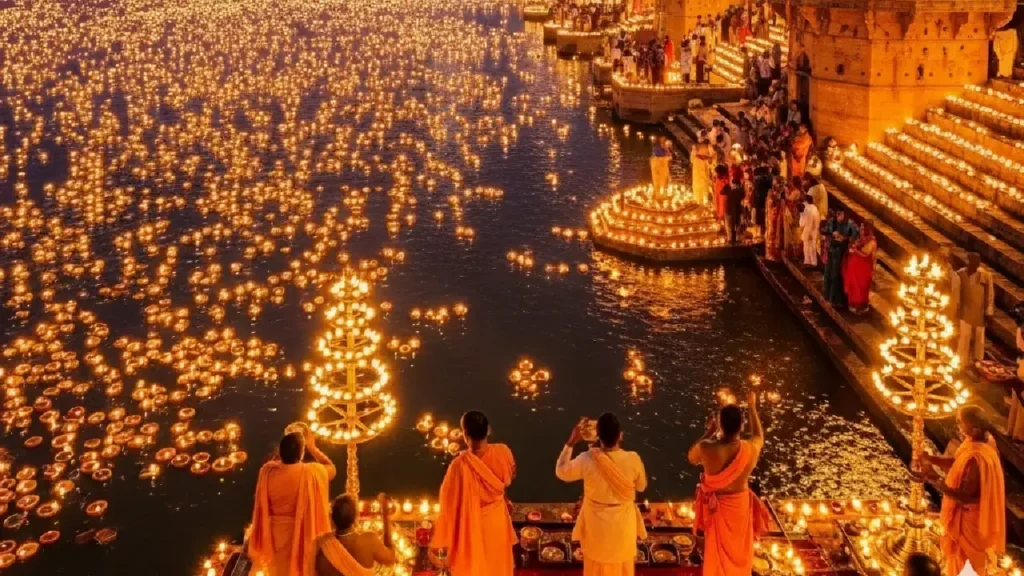
Unlike the household-centered Diwali, Dev Deepawali is a collective celebration on the ghats of Varanasi. The sight of thousands of devotees taking a holy dip at dawn, priests performing elaborate rituals, and the Ganga Aarti with synchronized chants elevates the spiritual aura of the event.
It’s not just a festival; it’s a moment where time seems to pause, and the divine essence of Varanasi reveals itself.
Difference Between Diwali and Dev Deepawali
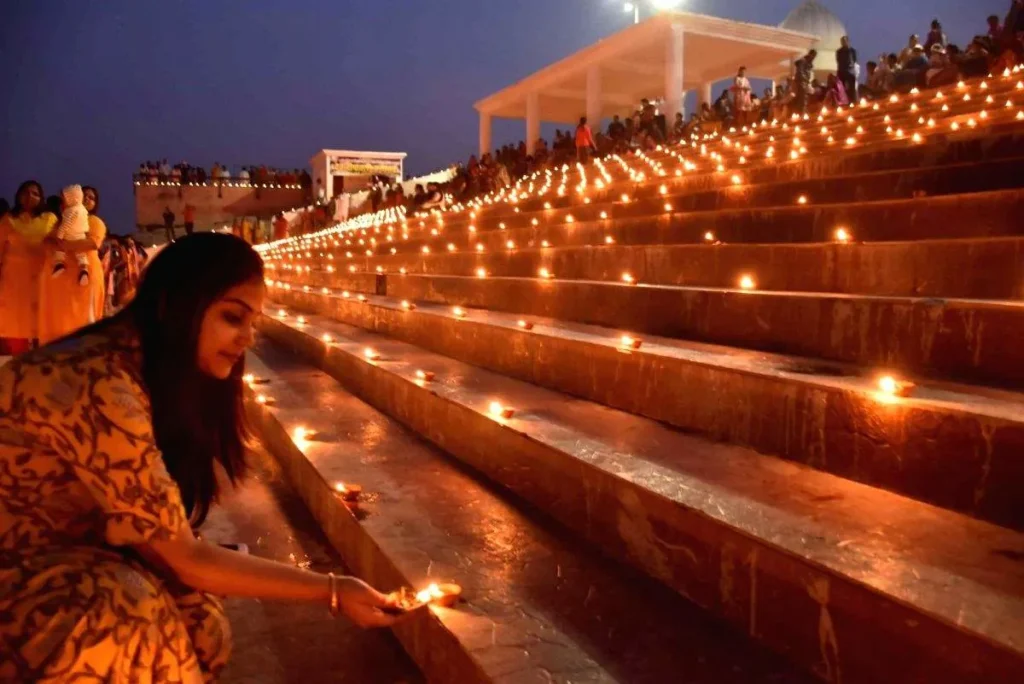
Though the names sound similar, Diwali and Dev Deepawali have distinct significance:
- Diwali: Celebrated across India, marking Lord Rama’s return to Ayodhya.
- Dev Deepawali: Exclusive to Varanasi, honoring the victory of Lord Shiva over demon Tripurasura.
The unique aspect of Dev Deepawali lies in its grand public rituals on the riverbanks, making it a one-of-a-kind experience.
Historical and Cultural Significance
Mythological Origins of Dev Deepawali
According to legend, Lord Shiva defeated Tripurasura on Kartik Purnima, liberating the universe from tyranny. To commemorate this, gods themselves are believed to descend to the Ganges to celebrate with lights.
How the Festival Evolved Over Centuries?
While rooted in mythology, the public celebration of Dev Deepawali gained prominence in the 20th century. Today, it’s not just a religious observance but a cultural showcase featuring music, dance, and spiritual gatherings.
When and Where Dev Deepawali is Celebrated?
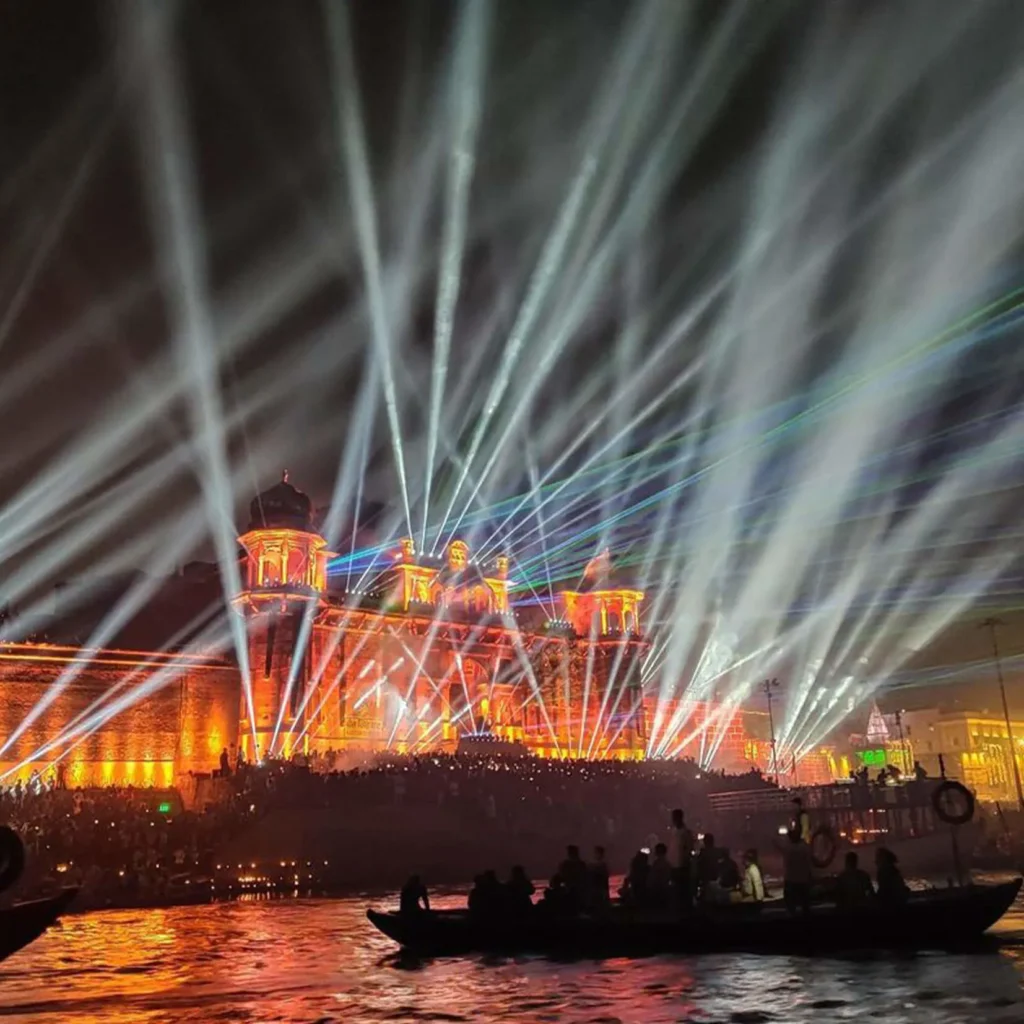
Date and Timing of Dev Deepawali 2025
In 2025, Dev Deepawali will be celebrated on November 5th, falling on Kartik Purnima. The day begins with Ganga Snan (ritual bathing) at sunrise and culminates with Ganga Aarti and lamp-lighting in the evening.
Major Ghats Where Celebrations Take Place
Though the entire riverfront glows, the most spectacular ghats include:
- Dashashwamedh Ghat – Known for its grand Ganga Aarti.
- Assi Ghat – Popular among youth and tourists.
- Panchganga Ghat – Historically revered for confluences of five rivers.
Key Highlights of Dev Deepawali
The Evening Aarti on the Ganges
Priests dressed in traditional attire perform synchronized rituals with conch shells, incense, and fire lamps, creating a spectacle that leaves visitors spellbound.
Millions of Diyas Lighting Up the Ghats
As dusk falls, more than a million earthen lamps illuminate the riverbanks, reflecting in the Ganges like stars on water.

Cultural Programs and Traditional Music
Folk artists and classical performers enthrall the audience with Kathak dances, devotional songs, and instrumental recitals, adding cultural depth to the spiritual night.
Rituals and Traditions of the Festival
Ganga Snan (Holy Dip in the Ganges)
Devotees believe that bathing in the Ganges on Kartik Purnima washes away sins and brings blessings of the gods.
Offerings and Prayers by Devotees
Thousands of devotees offer flowers, diyas, and sweets to the river, symbolizing devotion and gratitude.
Honoring Soldiers and Martyrs
A unique tradition of Dev Deepawali is the homage paid to soldiers who sacrificed their lives for the nation, blending patriotism with spirituality.
Best Spots to Witness Dev Deepawali

Assi Ghat
One of the liveliest spots in Varanasi, Assi Ghat is favored by young crowds, students, and foreign travelers. The atmosphere here is vibrant with cultural performances, devotional singing, and street food stalls that stay open till late night.
Dashashwamedh Ghat
The beating heart of Varanasi, Dashashwamedh Ghat is where the grand Ganga Aarti takes place. Watching the synchronized rituals under the golden glow of thousands of diyas is a once-in-a-lifetime experience.
Panchganga Ghat
Steeped in mythological significance, Panchganga Ghat is believed to be the confluence of five sacred rivers. It offers a slightly less crowded yet deeply spiritual atmosphere for witnessing the festival.
Travel Guide for Visitors
How to Reach Varanasi (Air, Rail, Road)
- By Air: Lal Bahadur Shastri International Airport connects Varanasi to major cities like Delhi, Mumbai, and Kolkata.
- By Rail: Varanasi Junction and Mughal Sarai are the main railway hubs with excellent connectivity.
- By Road: National highways and state-run buses ensure smooth travel for those arriving by road.
Where to Stay During Dev Deepawali
Accommodation options range from luxury river-facing hotels like BrijRama Palace and Taj Ganges to budget stays and ashrams near the ghats. For the best experience, book at least 2–3 months in advance.
Best Viewing Points for Tourists
- From a boat ride on the Ganges, offering panoramic views of illuminated ghats.
- From hotel balconies or rooftop cafes overlooking the river.
- From the ghats themselves, though it can get very crowded.
Things to Do in Varanasi During Dev Deepawali
Boat Rides on the Ganges
A boat ride at dusk lets you witness the reflection of thousands of diyas shimmering on the water — a photographer’s dream.
Exploring Varanasi’s Temples
Visit iconic temples like Kashi Vishwanath, Sankat Mochan, and Durga Kund to experience the spiritual side of the festival.
Street Food and Local Delicacies
No trip to Varanasi is complete without tasting kachori-sabzi, tamatar chaat, malaiyyo (a winter delicacy), and Banarasi paan.
Tips for First-Time Visitors
Safety and Crowd Management
Varanasi gets extremely crowded during Dev Deepawali. Keep your belongings safe, avoid overcrowded boats, and follow local police instructions.
Best Time to Arrive for Aarti
Reach the ghats 2–3 hours before the evening Aarti to secure a good viewing spot.
Photography and Drone Guidelines
Photography is allowed, but be respectful of rituals. Drones require special permission from local authorities due to security concerns.
Beyond the Festival: Exploring Varanasi
Banaras Hindu University and Bharat Kala Bhavan
A serene campus with a world-class museum showcasing artifacts, paintings, and sculptures from Indian history.
Sarnath Excursion
Located just 10 km from Varanasi, Sarnath is where Lord Buddha delivered his first sermon. Its stupas and museums are must-visits.
Shopping in Local Bazaars
Varanasi is famous for Banarasi silk sarees, brassware, wooden toys, and handicrafts. The bustling lanes of Vishwanath Gali and Thatheri Bazaar are shopper’s paradises.
Sustainable Tourism During Dev Deepawali
Eco-Friendly Practices for Devotees
To protect the Ganges, many locals encourage using eco-friendly diyas and minimizing plastic usage during celebrations.
Role of Volunteers in Cleanliness Drives
Numerous NGOs and volunteer groups conduct post-festival cleaning drives, ensuring the ghats remain pristine even after massive gatherings.
FAQs on Dev Deepawali in Varanasi
What is the difference between Diwali and Dev Deepawali?
Diwali is a nationwide festival celebrating Lord Rama’s return, while Dev Deepawali is unique to Varanasi, honoring Lord Shiva’s victory over Tripurasura.
When will Dev Deepawali be celebrated in 2025?
Dev Deepawali falls on November 5, 2025, coinciding with Kartik Purnima.
Which ghats are best for viewing Dev Deepawali?
Dashashwamedh, Assi, and Panchganga Ghats are the top spots, though almost the entire riverfront lights up.
Can tourists take part in lighting diyas?
Yes! Many locals invite tourists to light diyas and join the celebrations on the ghats.
Is it safe to travel during Dev Deepawali?
Yes, but due to large crowds, it’s advised to stay cautious, pre-book accommodations, and follow safety instructions.
What are must-try foods during the festival?
Don’t miss tamatar chaat, kachori-sabzi, malaiyyo, and Banarasi paan while exploring the streets of Varanasi.
Conclusion:
Dev Deepawali in Varanasi is more than a festival; it’s a divine spectacle that unites spirituality, culture, and community. The shimmering diyas, soulful chants, and sacred rituals turn the ghats into a celestial stage, offering visitors a chance to experience the very soul of India.
For travelers seeking a mix of devotion, tradition, and unforgettable visuals, Dev Deepawali on the banks of the Ganges is truly a once-in-a-lifetime journey.

